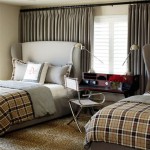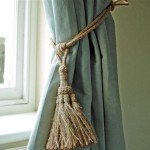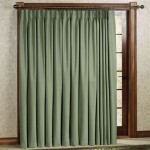Curtains for Big Living Room Windows: A Comprehensive Guide
Large living room windows offer numerous advantages, including abundant natural light, expansive views, and a connection with the outdoors. However, effectively managing these large windows through window treatments, especially curtains, presents unique challenges. Selecting the right curtains involves considering factors such as light control, privacy, insulation, acoustics, aesthetics, and operational functionality. This article provides a comprehensive guide to choosing the most suitable curtains for large living room windows, exploring various aspects to aid in making an informed decision.
Understanding the Challenges of Large Windows
Large windows, while desirable, pose specific considerations that impact the selection of window treatments. One primary concern is light control. Unfiltered sunlight can lead to glare, overheating, and fading of furniture and flooring. Curtains must effectively regulate the amount of light entering the room, allowing for comfortable and controlled illumination. Similarly, privacy is a crucial factor, particularly for living rooms facing neighboring properties or busy streets. Curtains should offer sufficient coverage to prevent unwanted views into the living space. Thermal insulation is another significant challenge. Large windows can be a major source of heat loss in winter and heat gain in summer, affecting energy efficiency and indoor comfort. Curtains can act as a barrier, reducing heat transfer and minimizing energy consumption. Finally, acoustics can be affected by large expanses of glass, which can amplify sound reflections and create echo. Curtains made of sound-absorbing materials can help improve the acoustic environment of the living room.
Addressing these challenges requires careful consideration of the various options available in terms of curtain fabrics, styles, and operational mechanisms. The following sections will delve into these aspects, providing a detailed examination of relevant factors.
Fabric Selection: Balancing Functionality and Aesthetics
The choice of fabric is arguably the most critical aspect of selecting curtains for large living room windows. Fabric dictates the curtain's appearance, performance, and longevity. Different fabrics offer varying degrees of light control, privacy, insulation, and acoustic properties. Therefore, understanding the characteristics of different materials is essential for making an informed decision.
For optimal light control, blackout fabrics are a popular choice. These fabrics are tightly woven and often feature a special coating that blocks out nearly all light. Blackout curtains are ideal for living rooms used as home theaters or for individuals sensitive to light. Dimout fabrics offer a slightly less extreme level of light control, allowing some light to filter through while still significantly reducing glare and brightness. These fabrics are suitable for living rooms where complete darkness is not required but a controlled level of illumination is desired.
In terms of privacy, heavier fabrics such as velvet, tweed, and brocade offer the most comprehensive coverage. These fabrics are dense and opaque, effectively preventing views into the living room. However, they can also block a significant amount of light, potentially making the room feel darker. Sheer and semi-sheer fabrics, on the other hand, offer minimal privacy but allow ample light to enter. These fabrics are often used in combination with other window treatments, such as blinds or shades, to provide a layered approach to light control and privacy.
Thermal insulation is another crucial consideration. Fabrics such as wool, fleece, and thermal-lined materials offer excellent insulation properties. These fabrics trap air, creating a barrier that reduces heat transfer. Thermal curtains can significantly improve energy efficiency, especially in homes with single-pane windows or older construction. Lighter fabrics such as linen and cotton offer less insulation but are still preferable to bare windows in terms of reducing heat gain in summer.
To enhance the acoustic properties of the living room, fabrics with sound-absorbing qualities are recommended. Velvet, suede, and other textured fabrics are effective at dampening sound reflections and reducing echo. These fabrics can contribute to a more comfortable and tranquil living environment. The weight and thickness of the fabric also influence its sound-absorbing capabilities, with heavier and denser fabrics generally performing better.
Beyond these functional attributes, the aesthetic appeal of the fabric is equally important. The fabric should complement the existing décor of the living room and contribute to the overall design aesthetic. Consider the color, pattern, texture, and drape of the fabric to ensure that it aligns with the desired look and feel of the space. Neutral colors such as beige, gray, and white are versatile and can blend seamlessly with various décor styles. Bold colors and patterns can add visual interest and personality to the living room but should be used judiciously to avoid overwhelming the space.
Curtain Styles and Operational Mechanisms
The style of curtain and its operational mechanism contribute significantly to both the functionality and aesthetics of the window treatment. Various styles offer different levels of light control, privacy, and visual appeal. Understanding these differences is essential for selecting the most appropriate style for large living room windows.
Panel curtains are a classic and versatile option. These curtains consist of individual fabric panels that hang from a rod. Panel curtains are relatively easy to install and operate and can be customized with a wide range of fabrics and patterns. They offer a clean and simple look that complements various décor styles. The degree of light control and privacy provided by panel curtains depends on the fabric chosen. These are often used in multiples on large windows to ensure adequate coverage.
Pleated curtains add a touch of elegance and sophistication to the living room. Pleats create a structured and tailored look, enhancing the visual appeal of the curtains. Various pleat styles are available, including pinch pleat, goblet pleat, and pencil pleat, each offering a unique aesthetic. Pleated curtains are often more formal than panel curtains and are well-suited for traditional or transitional décor styles. Pleated curtains require more fabric than panel curtains, resulting in a fuller and more luxurious appearance.
Grommet curtains feature metal rings or grommets along the top edge, allowing them to slide easily along a rod. Grommet curtains offer a modern and contemporary look and are easy to install and operate. The grommets create uniform folds, resulting in a clean and streamlined appearance. Grommet curtains are a popular choice for casual and modern living rooms.
Rod pocket curtains feature a sewn-in pocket at the top edge that slides directly onto the rod. Rod pocket curtains offer a simple and gathered look and are easy to install. However, they can be more challenging to operate than grommet or pleated curtains, as the fabric tends to bunch up on the rod. Rod pocket curtains are often used in more informal settings.
Beyond the style of curtain, the operational mechanism is also an important consideration. Manual curtains are operated by hand, either by pulling the fabric directly or by using a draw cord. Manual curtains are a cost-effective option and are suitable for windows that are not frequently opened or closed. Motorized curtains, on the other hand, are operated by a remote control or a wall switch. Motorized curtains offer convenience and ease of use, particularly for large or hard-to-reach windows. They can also be integrated with home automation systems for seamless control and scheduling. Track systems allow for smooth and quiet operation, facilitating the effortless opening and closing of curtains.
Choosing the right combination of curtain style and operational mechanism depends on the individual needs and preferences of the homeowner. Consider the size and placement of the windows, the frequency of operation, and the desired level of convenience to make an informed decision.
Additional Considerations for Large Living Room Windows
Beyond fabric selection and curtain style, several other factors should be considered when choosing curtains for large living room windows. These include the length and width of the curtains, the type of hardware used, and the overall design aesthetic of the room.
The length and width of the curtains should be carefully considered to ensure proper coverage and visual appeal. Curtains should ideally extend to the floor or slightly below to create a sense of height and elegance. Puddling curtains, which extend several inches beyond the floor, can add a touch of drama but may also be impractical for high-traffic areas. The width of the curtains should be at least twice the width of the window to create fullness and prevent the fabric from appearing stretched or skimpy. Consider using multiple panels to achieve the desired width.
The type of hardware used, including the rod, brackets, and rings, also plays a crucial role in the overall appearance and functionality of the curtains. The rod should be sturdy enough to support the weight of the curtains and should extend beyond the window frame on both sides to allow the curtains to be fully opened. The brackets should be securely mounted to the wall to prevent the rod from sagging or falling. The rings or hooks should be compatible with the curtain style and should allow for smooth and easy movement along the rod. Decorative hardware can add a touch of personality and style to the window treatment.
The overall design aesthetic of the room should also be considered when choosing curtains. The curtains should complement the existing décor and contribute to the overall look and feel of the space. Consider the color palette, pattern, texture, and style of the furniture, flooring, and accessories to ensure that the curtains harmonize with the existing elements. Neutral-colored curtains are a safe and versatile choice that can blend seamlessly with various décor styles. Bold-colored or patterned curtains can add visual interest and personality but should be used judiciously to avoid overwhelming the space.
Finally, professional installation is recommended for large or complex window treatments. A professional installer can ensure that the curtains are properly measured, cut, and installed, resulting in a flawless and long-lasting result. Proper installation is particularly important for motorized curtains and other advanced window treatments.

Curtain Ideas For Large Living Room Windows In Depth Review Homerilla

Budget Friendly Living Room Window Treatments

Window Treatments For Large Windows The Shade Blog

Window Treatments For Tall Windows Lerner Interiors

100 Blackout Extra Long Linen Curtains Custom Made 9 24 Feet Length Wide 2 Story Living Room Ikiriska Off White Gray Tall Ceiling Drapes Etsy

The Best Dressed Windows And How To Get Them New York Times

Curtains For Arched Windows Design Tips The Shade

Difficult Windows Window Treatment Dos And Don Ts Laurel Home

Curtains For Large Windows With Big Impact

6 Curtain Ideas For Wide Windows








